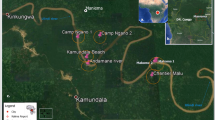Abstract
Bacteria are resistant to Hg compounds by virtue of two specific enzymes: mercuric reductase and organomercurial lyase. We investigate these specific enzyme systems 1) to determine McHg in biological samples by its enzymatic transformation to the respective hydrocarbon and 2) as an environmental index of Hg pollution in geothermal areas, by studying the distribution of the percentage of Hg-resistant bacteria.
The first application is based on the enzymatic conversion of McHg to CH4. by whole cells of the Pseudomonas putida strain FBI. A 1 ml aliquot of 0.01N aqueous solution of thiosulphate containing MeHg, extracted from a biological sample by a conventional procedure was mixed with a dense (1 mg cells/mL dw) culture of FBI strain in a microreaction vessel. After a suitable period of incubation (from 4 to 18 hours), methane was assayed in the headspace by gas chromatograph equipped with flame ionization detector.
In the second application, Hg-resistant bacteria (MRB) isolated from mosses collected in a geothermal area (Travale) in Tuscany showed almost the same distribution pattern as total Hg in briophytes. Mosses and MRB are both suitable bioindicators for mapping contaminated areas. The finding of Hg-resistant strains depends on the availability of the metal for cell accumulation and interaction at molecular level in the cytoplasm to produce mercuric reductase. MRB/g dw is therefore an indirect measure of the enzyme in this terrestrial geothermal environment.
Similar content being viewed by others
References
Anderson, F.K., and Treshow M.: 1984 In Air Pollut. Plant Life, Ed. Treshow, M. John Wiley & Sons Ltd pp.259.
Baldi, F., Olson, G.J., and Brinckman, F.E.: 1985. Geomicrobiol. J., 5, Geomicrobiol. J., 5, 1.
Baldi, F.: 1987. Water,Soil Air Pollut. 38, 111.
Baldi, F., Coratza, G., Manganelli, R., and Pozzi, G.: 1988a. Microbios 54, 7
Baldi, F., E. Cozzani, and M. Filippelli: 1988b. Environ. Sci.Technol. 22, 836
Baldi, F., Filippelli, M. and Olson, G.J., 1989: Microbiol. Ecol. 17, 263.
Baldi, F and Filippelli, M.: 1990. Env.Sci.Technol. (in press).
Baldi, F., Boudou, A., and Ribeyre: Water Res. (submitted).
Barkay, T., Fouts, D.L., Olson, B.H.,:1985. Appl. Environ. Microbiol., 49, 686
Barkay, T., and Olson, B.H.: 1986, Appl.Environ.Microbiol. 52,403.
Barkay, T.: 1987, Appl.Environ.Microbiol., 53, 2725.
Barkay, T., Liebert, C., and Gillman, M.: 1990 Appl. Environ. Microbiol. 56,1695
Barrineau, P., Gilbert, P., Jackson, W.J., Jones,C.S., Summers, A.O., and Wisdom, S.:1984. J. Mol. Appl. Genet. 2, 601.
Bennett, P. M., Grinsted, J.,Choi,C.-L., and Richmond, M. H: 1978. Mol. Gen. Genet., 159, 101.
Booth, J. I, and Williams, J.W.: 1984, J.General Microbiol. 130, 725.
Brown N. L.: 1985, Trends Biochem.Sci.,41,400.
Filippelli, M.:1986., Anal. Chem., 59,116.
Furukawa, K. Suzuki, T., and Tonomura, K.:1969, Agric.Biol.Chem., 33,128.
Furukawa,K. and Tonomura,K.:1972, Agric.Biol. Chem., 36, 217.
Hansen, C.L., Zwolinski, Martin, D., and Williams, J.W.: 1984, Biotechnol. Bioengineering, 26,1330.
Moore, B.:1960,.Lancet, 2: 453.
Nakamura, K. Fujisaki, T., and Tamashiro, H.: 1986. Environ. Res. 40, 58.
Nelson,J. D., and Colwell, R. R.:1975, Microbial. Ecol. 1,191.
Novick, R. T. and Roth, C., 1968, J. Bacteriol. 95,1335.
Ogawa, H. I., Tolle, C. L., Summers, A.O.:1984, Gene 32, 311.
Porter, F. D., Silver, S., Ong, C., and Nakamara, H.:1982, Antimicrob.Agents Chemother. 22, 852.
Rasmussen,L.:1977, Environ.Pollut.,14, 37.
Report No. 26. 1985. International Atomic Agency, Laboratory of Marine Radioactivity, Oceanographic Museum; Monaco-Montecarlo, October 1985.
Robinson,J. B., and Tuovinen,O.H.:1984. Microbial Rev. 48,95.
Stoeppler, M., and Backhaus, F.:1978. Fresenius Z. Anal. Chem., 291, 116.
Tezuka,T. and Tonomura, K.:1976, J. Biochem.(Tokio) 80, 79.
Author information
Authors and Affiliations
Rights and permissions
About this article
Cite this article
Baldi, F., Semplici, F. & Filippelli, M. Environmental applications of mercury resistant bacteria. Water, Air, and Soil Pollution 56, 465–475 (1991). https://doi.org/10.1007/BF00342292
Issue Date:
DOI: https://doi.org/10.1007/BF00342292




